Abstract
A colonial variant of a virulent Shigella flexneri 2a has lost both virulence and glycerol kinase activity. It also has several other altered characteristics: lowered ability to oxidize tricarboxylic acid cycle intermediates, increased electrophoretic mobility, and decreased sensitivity to sodium lauryl sulfate. Genetic analysis has revealed that the gene governing glycerol kinase activity in Shigella has a different chromosomal locus than that from Escherichia coli. Furthermore, transduction of the Shigella glycerol kinase gene (glp K) into the avirulent Shigella strain can restore the ability to penetrate HeLa cells, whereas the gene from E. coli cannot. About half of the glp K mutants lose this ability, and only about half of the revertants of an avirulent glp K mutant regain it. This indicates that more than one gene affects glycerol kinase activity in Shigella, only one of which is associated with penetration. Glycerol kinase activity is closely correlated with changes in electrophoretic mobility, but does not appear to have any relationship to sodium lauryl sulfate sensitivity nor to the oxidation of tricarboxylic acid cycle intermediates.
Full text
PDF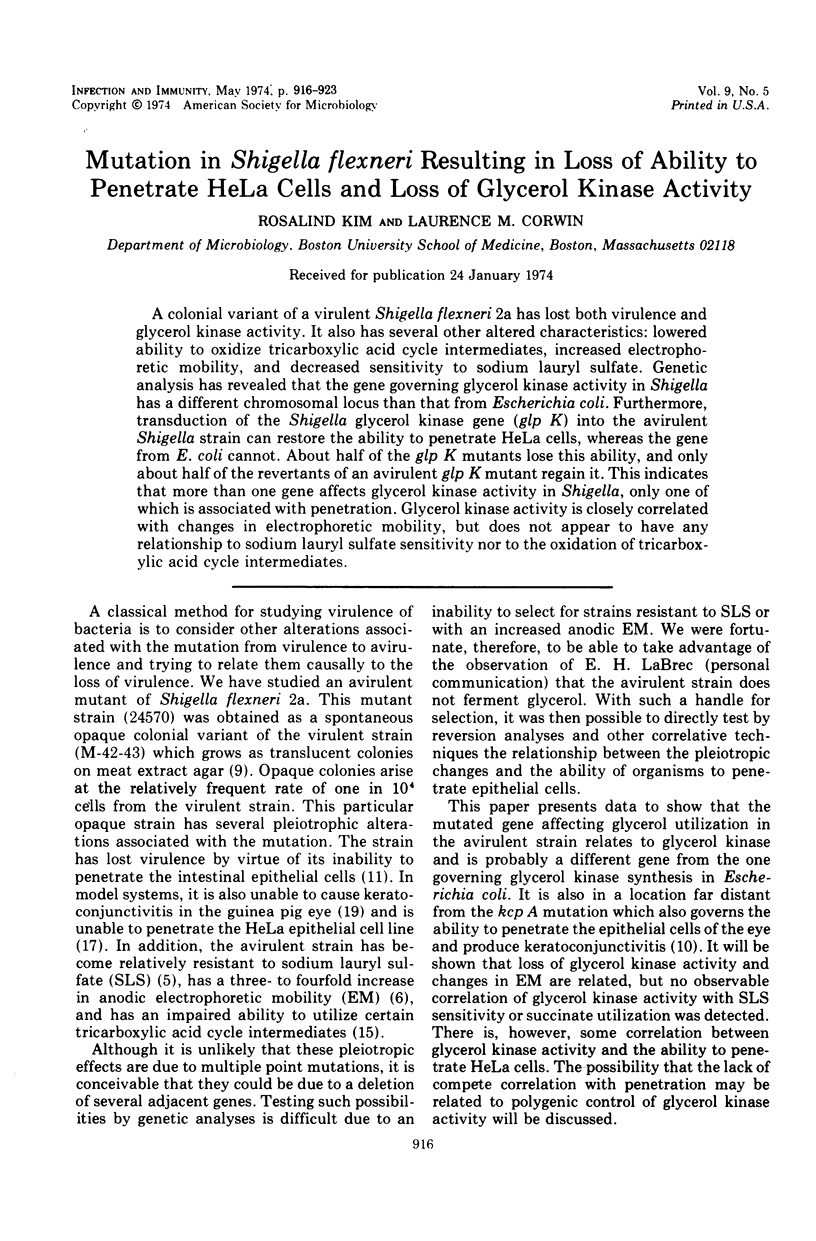
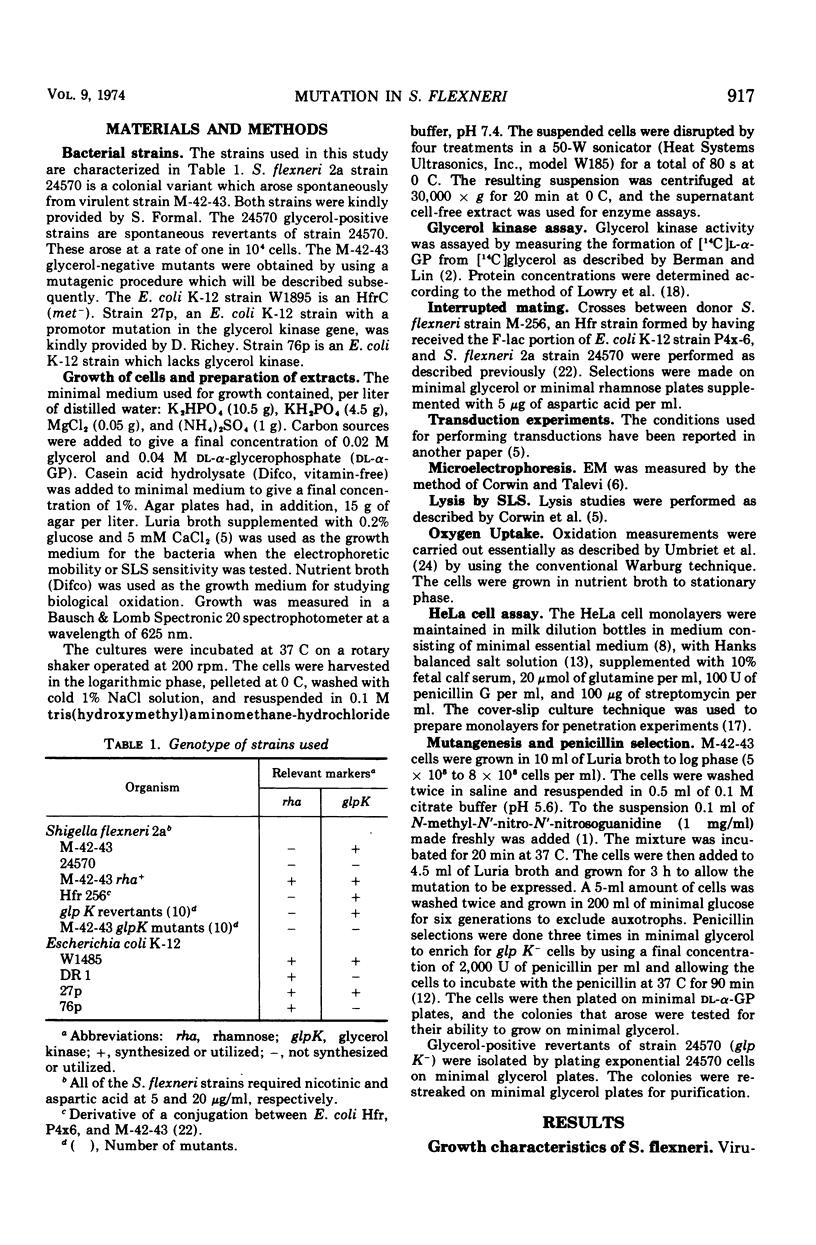
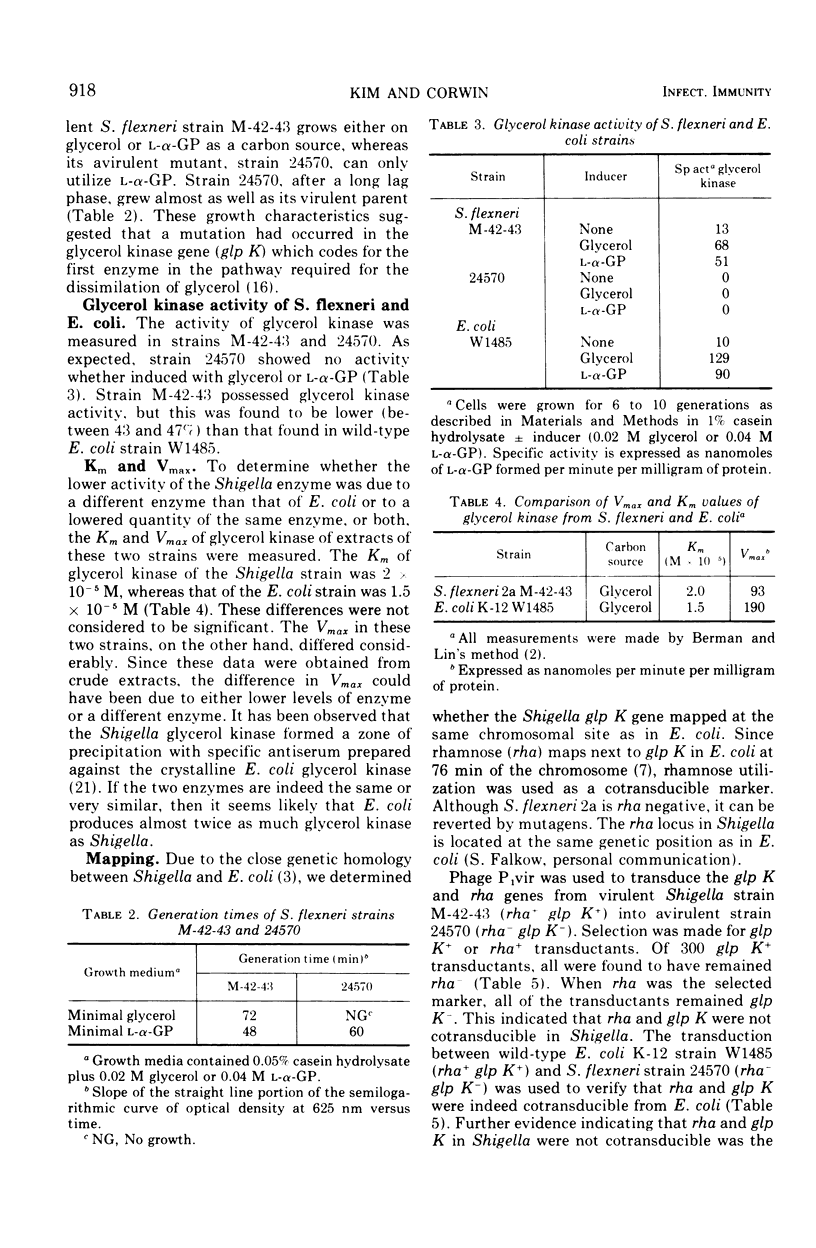
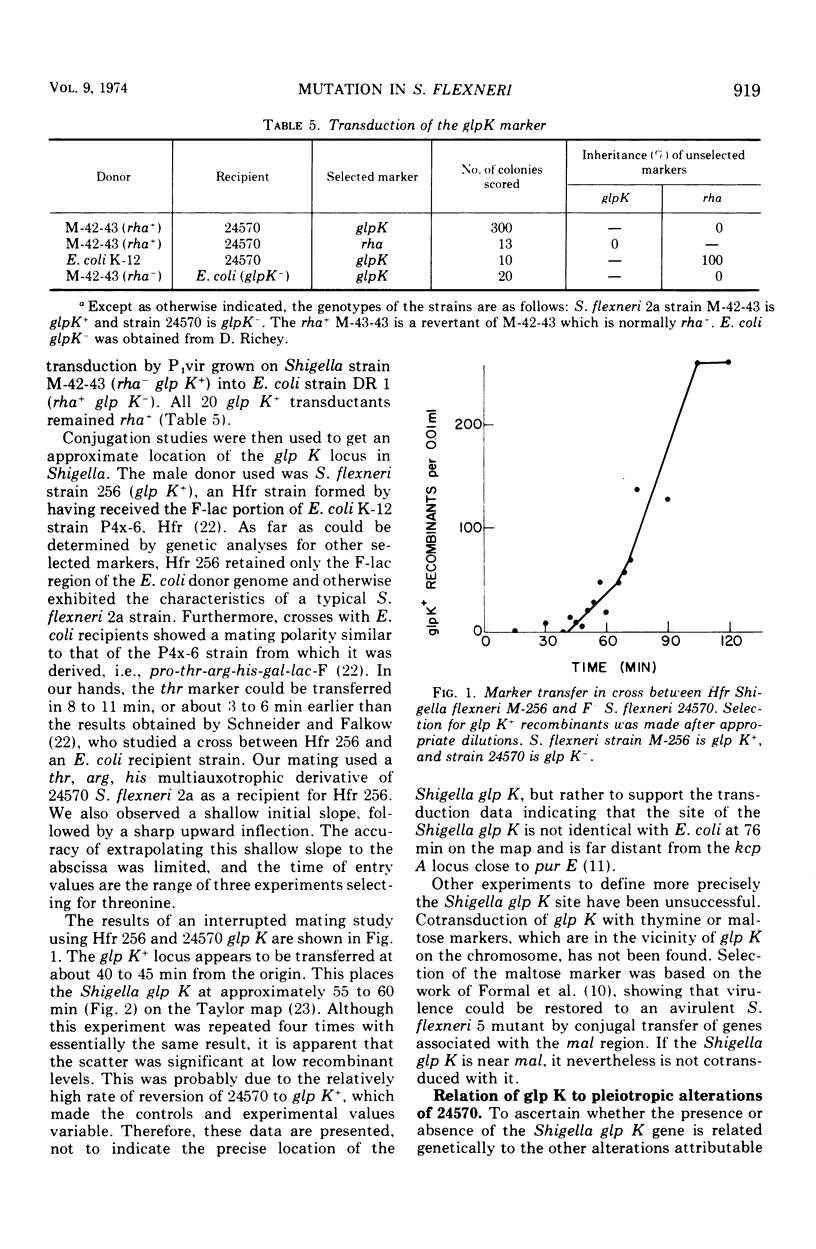
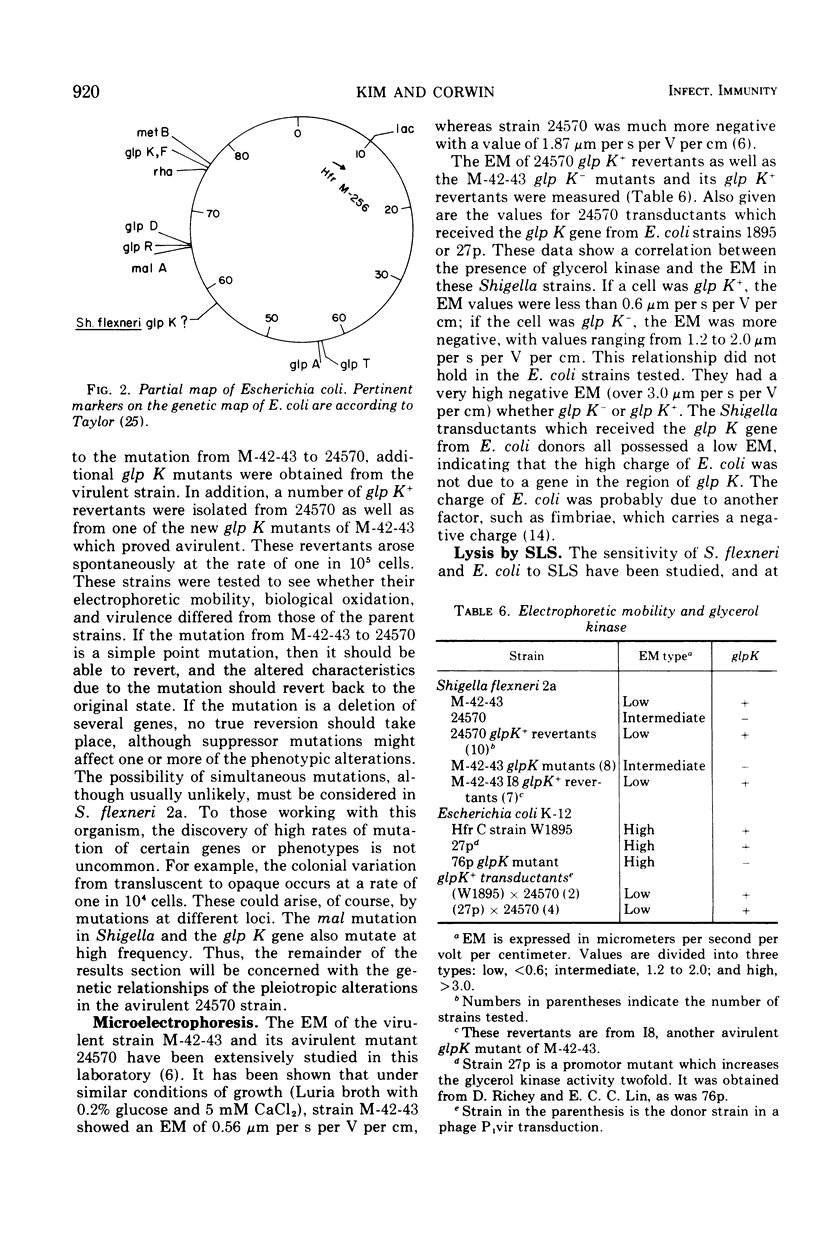
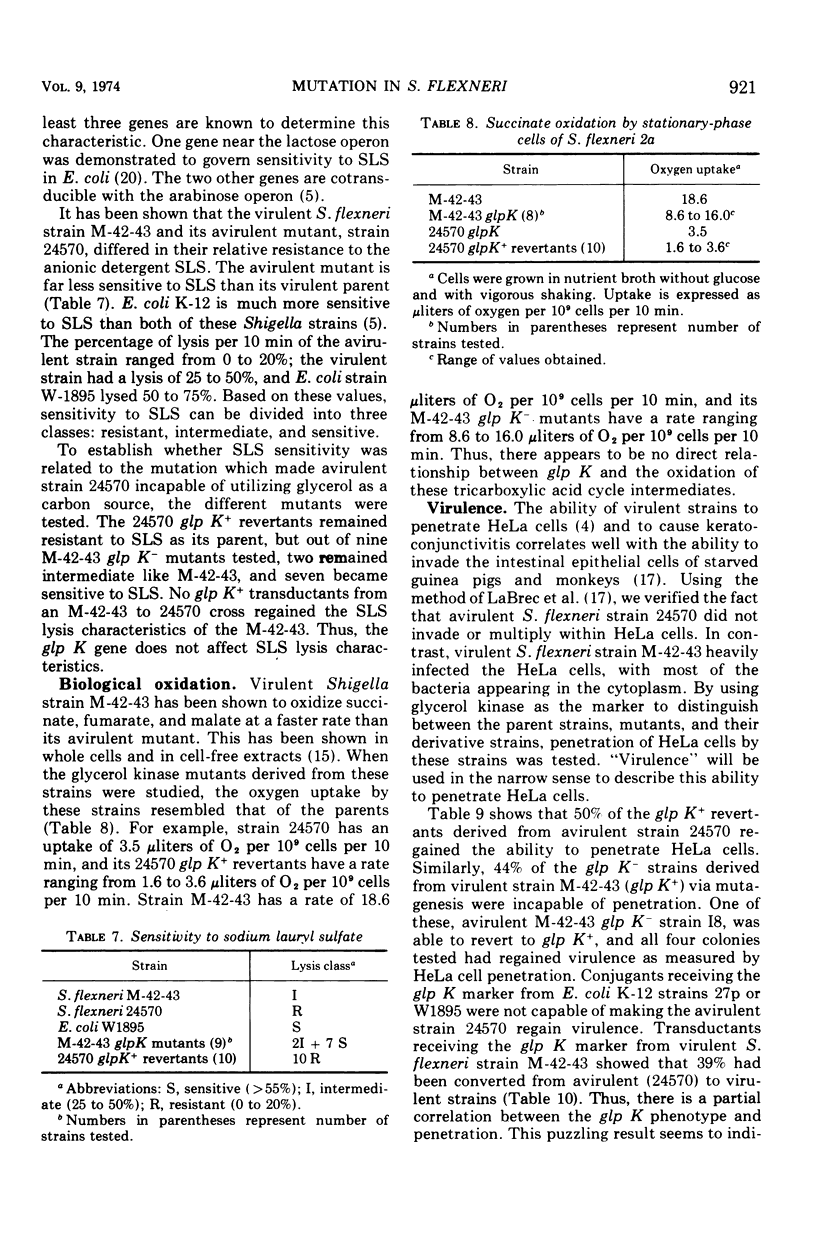
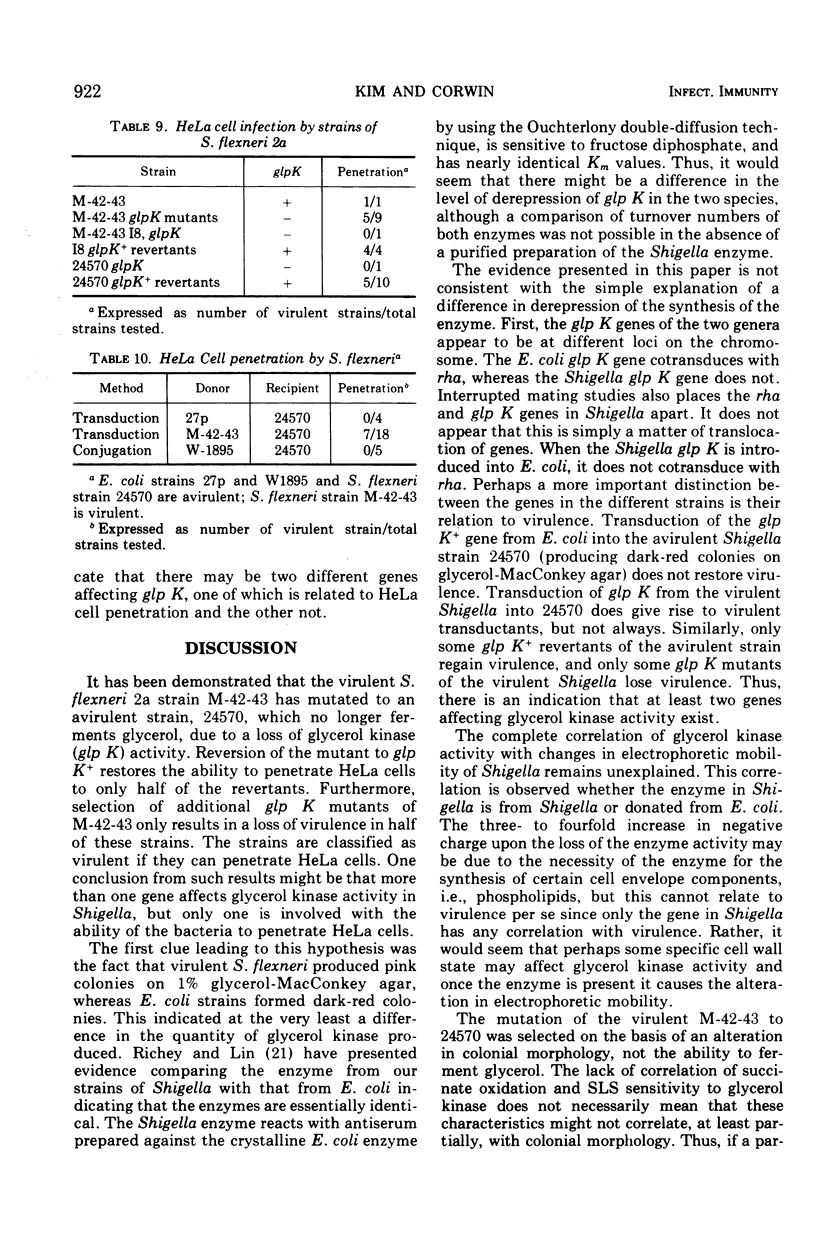

Selected References
These references are in PubMed. This may not be the complete list of references from this article.
- Berman M., Lin E. C. Glycerol-specific revertants of a phosphoenolpyruvate phosphotransferase mutant: suppression by the desensitization of glycerol kinase to feedback inhibition. J Bacteriol. 1971 Jan;105(1):113–120. doi: 10.1128/jb.105.1.113-120.1971. [DOI] [PMC free article] [PubMed] [Google Scholar]
- Brenner D. J., Fanning G. R., Skerman F. J., Falkow S. Polynucleotide sequence divergence among strains of Escherichia coli and closely related organisms. J Bacteriol. 1972 Mar;109(3):953–965. doi: 10.1128/jb.109.3.953-965.1972. [DOI] [PMC free article] [PubMed] [Google Scholar]
- Calabi O. In-vitro interaction of Shigella flexneri with leukocytes and HeLa cells. J Infect Dis. 1970 Jul-Aug;122(1):1–9. doi: 10.1093/infdis/122.1-2.1. [DOI] [PubMed] [Google Scholar]
- Corwin L. M., Rothman S. W., Kim R., Talevi L. A. Mechanisms and genetics of resistance to sodium lauryl sulfate in strains of Shigella and Escherichia coli. Infect Immun. 1971 Sep;4(3):287–294. doi: 10.1128/iai.4.3.287-294.1971. [DOI] [PMC free article] [PubMed] [Google Scholar]
- Corwin L. M., Talevi L. A. Mutation in Shigella flexneri 2a resulting in increased electrophoretic mobility. Infect Immun. 1972 May;5(5):798–802. doi: 10.1128/iai.5.5.798-802.1972. [DOI] [PMC free article] [PubMed] [Google Scholar]
- Cozzarelli N. R., Lin E. C. Chromosomal location of the structural gene for glycerol kinase in Escherichia coli. J Bacteriol. 1966 May;91(5):1763–1766. doi: 10.1128/jb.91.5.1763-1766.1966. [DOI] [PMC free article] [PubMed] [Google Scholar]
- EAGLE H. The minimum vitamin requirements of the L and HeLa cells in tissue culture, the production of specific vitamin deficiencies, and their cure. J Exp Med. 1955 Nov 1;102(5):595–600. doi: 10.1084/jem.102.5.595. [DOI] [PMC free article] [PubMed] [Google Scholar]
- FALKOW S., SCHNEIDER H., BARON L. S., FORMAL S. B. VIRULENCE OF ESCHERICHIA-SHIGELLA GENETIC HYBRIDS FOR THE GUINEA PIG. J Bacteriol. 1963 Dec;86:1251–1258. doi: 10.1128/jb.86.6.1251-1258.1963. [DOI] [PMC free article] [PubMed] [Google Scholar]
- Formal S. B., Gemski P., Baron L. S., Labrec E. H. A Chromosomal Locus Which Controls the Ability of Shigella flexneri to Evoke Keratoconjunctivitis. Infect Immun. 1971 Jan;3(1):73–79. doi: 10.1128/iai.3.1.73-79.1971. [DOI] [PMC free article] [PubMed] [Google Scholar]
- Formal S. B., Labrec E. H., Palmer A., Falkow S. Protection of Monkeys Against Experimental Shigellosis with Attenuated Vaccines. J Bacteriol. 1965 Jul;90(1):63–68. doi: 10.1128/jb.90.1.63-68.1965. [DOI] [PMC free article] [PubMed] [Google Scholar]
- GORINI L., KAUFMAN H. Selecting bacterial mutants by the penicillin method. Science. 1960 Feb 26;131(3400):604–605. doi: 10.1126/science.131.3400.604. [DOI] [PubMed] [Google Scholar]
- HARRIS J. O., KLINE R. M. Electrophoresis of motile bacteria. J Bacteriol. 1956 Oct;72(4):530–532. doi: 10.1128/jb.72.4.530-532.1956. [DOI] [PMC free article] [PubMed] [Google Scholar]
- KOCH J. P., HAYASHI S., LIN E. C. THE CONTROL OF DISSIMILATION OF GLYCEROL AND L-ALPHA-GLYCEROPHOSPHATE IN ESCHERICHIA COLI. J Biol Chem. 1964 Sep;239:3106–3108. [PubMed] [Google Scholar]
- Kim R., Corwin L. M. Factors affecting virulence of Shigella flexneri: avirulent strain with altered metablism of succinate, fumarate, and malate. Infect Immun. 1973 Apr;7(4):625–630. doi: 10.1128/iai.7.4.625-630.1973. [DOI] [PMC free article] [PubMed] [Google Scholar]
- LOWRY O. H., ROSEBROUGH N. J., FARR A. L., RANDALL R. J. Protein measurement with the Folin phenol reagent. J Biol Chem. 1951 Nov;193(1):265–275. [PubMed] [Google Scholar]
- Labrec E. H., Schneider H., Magnani T. J., Formal S. B. EPITHELIAL CELL PENETRATION AS AN ESSENTIAL STEP IN THE PATHOGENESIS OF BACILLARY DYSENTERY. J Bacteriol. 1964 Nov;88(5):1503–1518. doi: 10.1128/jb.88.5.1503-1518.1964. [DOI] [PMC free article] [PubMed] [Google Scholar]
- MACKEL D. C., LANGLEY L. F., VENICE L. A. The use of the guinea-pig conjunctivae as an experimental model for the study of virulence of Shigella organisms. Am J Hyg. 1961 Mar;73:219–223. doi: 10.1093/oxfordjournals.aje.a120179. [DOI] [PubMed] [Google Scholar]
- Nakamura H. Genetic determination of resistance to acriflavine, phenethyl alcohol, and sodium dodecyl sulfate in Escherichia coli. J Bacteriol. 1968 Oct;96(4):987–996. doi: 10.1128/jb.96.4.987-996.1968. [DOI] [PMC free article] [PubMed] [Google Scholar]
- Richey D. P., Lin E. C. Importance of facilitated diffusion for effective utilization of glycerol by Escherichia coli. J Bacteriol. 1972 Nov;112(2):784–790. doi: 10.1128/jb.112.2.784-790.1972. [DOI] [PMC free article] [PubMed] [Google Scholar]
- SCHNEIDER H., FALKOW S. CHARACTERIZATION OF AN HFR STRAIN OF SHIGELLA FLEXNERI. J Bacteriol. 1964 Sep;88:682–689. doi: 10.1128/jb.88.3.682-689.1964. [DOI] [PMC free article] [PubMed] [Google Scholar]
- Taylor A. L. Current linkage map of Escherichia coli. Bacteriol Rev. 1970 Jun;34(2):155–175. doi: 10.1128/br.34.2.155-175.1970. [DOI] [PMC free article] [PubMed] [Google Scholar]


